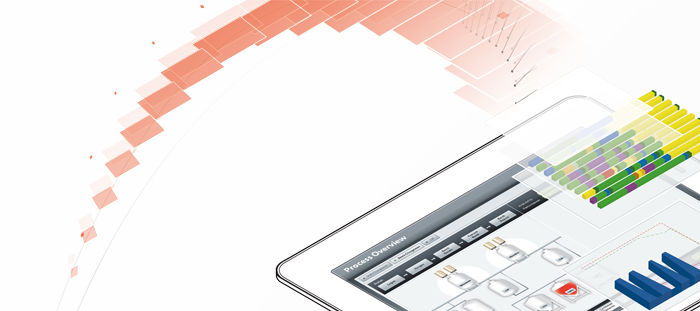Login (User Login; top right of page) with your web user or complete this form to download.
Horizontal and vertical integration in a Smart Factory

Industry 4.0: Networking, communication and efficiency
Industry 4.0 allows manufacturers to produce with greater flexibility, react more quickly and, in doing so, become even more efficient – with minimal consumption of resources.
The Internet was invented in order to use the capacities of mainframe computers more effectively. Even now, when we have the Internet of Things (IoT), networking and the integration it makes possible are still important factors for increased efficiency. For example, in the case of correlating production data from different sources within a manufacturing operation.
Two of the most important factors for production in a Smart Factory are horizontal and vertical integration. Horizontal integration means networking between individual machines, items of equipment or production units. Vertical integration networks beyond traditional production hierarchy levels — from the sensor to the business level of the company.
Essentially, horizontal integration ensures that machinery, IoT devices and engineering processes work together seamlessly. Vertical integration, on the other hand, allows production data to be used for making business, staffing and other decisions by allowing communication between the horizontally integrated shop floor network and other systems, such as Enterprise Resource Planning (ERP).
Horizontal and vertical integration challenges manufacturers face
In the interconnected Smart Factory, horizontal integration ensures machinery, IoT devices and engineering processes work together seamlessly. Vertical integration ensures production data is used at higher organizational levels when making marketing, staffing and other decisions.
Although horizontal and vertical integration can streamline production and enable smarter business decisions, the transition can pose some unique challenges related to:
- Lack of communication: Horizontal integration assumes that a factory has devices and software capable of collecting production data and sharing that data with other systems. To begin integration, you’ll need to either purchase new IoT-enabled equipment or change existing equipment to allow interconnectivity. Strategies for IoT enabling legacy systems include retrofitting them with sensors and connecting programmable logic controllers (PLCs) to the Internet using converters.
- Knowledge silos: Knowledge silos occur when a factory's different information systems are incapable of sharing data with one another, trapping information in one part of the machinery, production process or organization. If your architecture is already compatible and relatively new, you may be able to eliminate knowledge silos by simply integrating existing systems, setting them up to share data freely. In other cases, you may have to address incompatible architecture before you can share production data with the rest of the business.
- Asset management: Once you've integrated machines, data systems and devices in your Smart Factory, you must continue to manage these assets to assure security and productivity. Implementing continuous network monitoring and choosing industrial software with robust security features can help with asset management.
- Supply chain management: For horizontal and vertical integration to impact resource efficiency, supply chain management must be included in the network. Whether networking with external suppliers or integrating the internal supply chain, manufacturers need to leverage data-driven technology to ensure smooth collaboration and sound decision-making.
- Economies of scale: Different shop floors must be horizontally and vertically integrated individually. Surveys have shown that small and medium-sized businesses spend an average of $250,000 implementing Smart Factory technology, and large businesses are likely to spend even more. The lack of economy of scale means manufacturers must make a serious investment in technology, including new software for planning, controlling, visualizing and analyzing the operational performance. The investment usually pays off, though, as the integration results in more cost-effective production, consolidated management and reduced overhead costs.
Horizontal integration with zenon
In the typical manufacturing environment, horizontal integration must connect many types of equipment. As a hardware-independent system, zenon Software Platform from COPA-DATA makes connecting disparate machines in an existing system simple, supported by a variety of key features:
- Over 300 native communication protocols
- Multi-project administration
- Client/Server – Server/Client topology
- straton binding
- Application programming interface (API)
In one example, Sidel, a global packaging manufacturer, used zenon to integrate different PLC systems into a single platform independent of hardware and operating systems, significantly increasing management efficiency.
Vertical integration with zenon
Vertical integration creates connections between production and other parts of a manufacturing organization. Essentially, it networks beyond traditional production hierarchy levels — from the sensor to the business level of the company.
With user-friendly graphical interfaces and flexible reporting tools, COPA-DATA's zenon is ideal for vertical integration, with essential features such as:
- Over 300 native communication protocols
- ERP interface (SAP ERP, Microsoft Dynamics, etc.)
- SQL Server Interface
- Web Server or HTML5 Web Engine
- zenon Service Grid
- Everywhere Server (Smartphone App)
- Cloud integration
One pharmaceutical equipment manufacturer, SKAN AG, chose zenon as a uniform interface to connect the sensors with the MES and ERP level, leading to improved business decisions.
Contact COPA-DATA to assist in horizontal and vertical integration
Horizontal and vertical integration may seem like a challenge in a Smart Factory, but zenon can help you overcome integration difficulties and eliminate any doubts you may have about your ability to benefit from Industry 4.0 developments. This hardware-independent software platform can be easily integrated into your existing production assets, along with a user-friendly graphical interface and robust security features.
At COPA-DATA, we assist with your horizontal or vertical integration projects and provide solutions tailored to your unique requirements. To learn more, contact us today.
















































